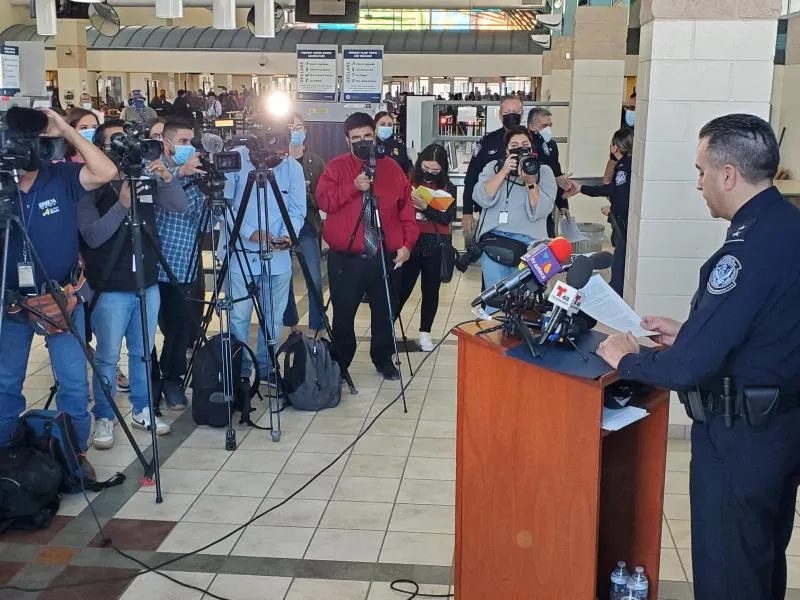EL PASO, Texas – U.S. Customs and Border Protection officials are asking for preparedness and patience as travelers are able to take advantage of the first stage of re-opening following pandemic travel restrictions.
Beginning in March 2020, to prevent the further spread of COVID-19, travel across the land border into the U.S. has been restricted to essential travel only. While U.S. citizens and legal permanent residents of the U.S. were able to cross the border, travel by visa holders from other nations was not permitted for non-essential reasons, such as tourism or family visits.

Provencio addresses media regarding
November 8 changes.
On November 8, fully vaccinated foreign nationals with appropriate documents for entry will be permitted to cross into the U.S. from Mexico at land border crossings for non-essential reasons again. These travelers are required to be prepared to attest to vaccination status and to present proof of vaccination to a CBP officer upon request.
By January, foreign nationals traveling across the land border for both essential and non-essential reasons will be required to be fully vaccinated. This includes individuals who have previously been crossing the border for essential travel, such as work or medical appointments. U.S. citizens and legal permanent residents of the U.S. will not be required to provide proof of vaccination when crossing into the U.S. The requirements also do not apply to those ages 17 and under.
Information about what is acceptable as proof of vaccination, including which vaccines are permissible, is available on the Centers for Disease Control and Prevention website: Requirement for Proof of COVID-19 Vaccination for Air Passengers | CDC. Please note that to be considered fully vaccinated, 14 days must have passed since your final shot for your vaccine.
“Traffic volumes were down at the beginning of the pandemic but since then they have grown consistently approaching pre-pandemic levels in some instances,” said Ray Provencio, acting El Paso Port Director. “We will be monitoring traffic and adjusting some staffing to meet the anticipated added demand. We are predicting longer wait times, and are asking for travelers to help us speed the process as much as possible by being prepared for the process.”
For the ports of entry along the U.S/Mexico border, CBP officials are suggesting the following steps that travelers can take to try and help speed processing for entry into the U.S.:
- If you are a visa holder traveling for non-essential reasons, you can verbally attest or declare to the officer that you have been vaccinated, without waiting for the officer to ask the question. Have your proof of vaccination ready, in case the officer asks to see it. (Not every individual will be asked to show their proof at every crossing, but they are required to have their proof of vaccination with them in case they are asked to provide it to the CBP officer as a part of their inspection for entry into the U.S.)
- If you are traveling for non-essential reasons, travel at off-peak times. At local ports of entry, our peak times with the highest traffic volumes are on Sundays and weekday mornings To help alleviate bottlenecks, CBP is recommending that those who can, decide when to cross choose off-peak hours for their travel times.
- For travelers in need of an I-94 permit or permiso, use the CBP One mobile app to apply and pay in advance of your crossing, up to seven days before you cross. Travelers can use the app on their phone to complete the application, receive conditional approval, and pay the fee for the permit. They can then complete the final step with the officer in the primary booth during their inspection for entry to the U.S. Using the app significantly improves the individual traveler’s crossing experience, as they do not need to go to secondary inspection for completion and can instead continue on their way. And using the app helps save time for everyone at the border crossing. For travelers who do not apply electronically, they should expect long wait times for processing.
- Use the correct lane. Traffic at our local ports of entry is segmented into three different lanes. The SENTRI lanes are only for those traveling in a vehicle with all of the occupants registered in the low-risk Trusted Traveler program; the vehicle itself must also be registered with SENTRI. The Ready lanes are only for those who have a document equipped to use the Radio Frequency Identification (RFID) technology available to help speed processing into the U.S. For U.S. citizens, that’s a passport card, rather than the blue passport book. It also includes Legal Permanent Resident Cards and the Border Crossing Cards held by local B1/B2 visa holders. All others must have their correct documentation ready to show that they have the legal status to enter the U.S., and use the general traffic lanes.
“We do anticipate more travelers, especially as we head into the holiday season. Everybody should expect longer wait times. That’s the reality of what we’re going to see,” said Provencio. “By being prepared to the point where every traveler can save just a few seconds in the process will add up into real time savings for all travelers at our local border crossings.”
Additional information about these changes to the travel restrictions are available from the DHS press release and Fact Sheet.

